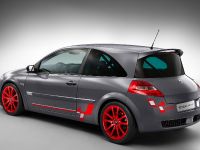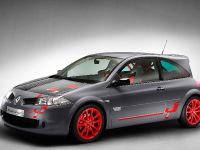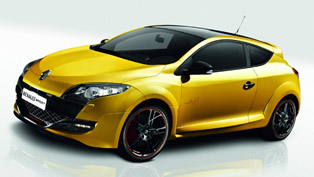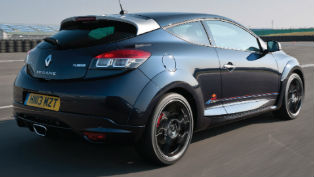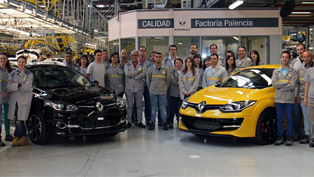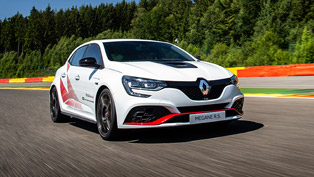Renault unveils Megane Renaultsport R26.R
The Mégane Renaultsport 230 F1 Team R26 was launched in November 2006 and has enjoyed a great success. Using this base, Renaultsport launch an extreme version, the Mégane Renaultsport R26.R. Developed by Renault Sport Technologies, the Mégane R26.R joins the family that also comprises the Clio Renaultsport 197, Mégane Renaultsport 225, Mégane Renaultsport dCi 175 and, from September, the Twingo Renaultsport 133. Since the launch in April 2004, the family of Mégane Renaultsport has sold more than 20,000 units in almost 30 countries.
The launch of this ultimate version underlines Renault Sport Technologies' role as a leading manufacturer of high performance cars.
Mégane R26.R has been developed to:
- offer customers who enjoy trackdays a car with an unrivalled performance per pound ratio
- be an enthusiast's icon
Radical looks
Renault Sport Technologies have given the Mégane R26.R visual differences that mark out the car at first glance. The carbon fibre bonnet and new 18" alloy wheels in red are the main visual clues together with a new rear spoiler, plus R26.R decals and logos and tinted polycarbonate in place of glass in the tailgate and rear side windows. The car is available in seven colours, two of which are new to the Mégane, Racing Blue and Renault i.d. Lunar Grey and one is brand new, Renault i.d. Pearlescent White.
Inside the R26.R the atmosphere is as radical as the outside. Competition seats with a carbon fibre shell are supplied by Sabelt who also supply the six-point harnesses, the first time that this form of restraint has been homologated in a production car. Conventional lap and diagonal seat belts can be fitted as an accessory. No rear seat is fitted. The steering wheel and gearlever gaiter are in leather and suede. A plaque shows the production number for each country:
- 230 for the UK
- 126 for France
- 26 for Spain
- 26 for Spain
- 26 for Germany
Lightweight DNA
To improve the power to weight ratio, the Mégane R26.R has been on a strict diet, losing 123kg compared to the standard R26. This has been achieved by the removal of:
- Rear seats and seat belts
- Passenger airbag and curtain airbags (the driver's airbag remains)
- Climate control (air conditioning remains as standard)
- Rear wash/wipe and heated rear window
- Front fog lamps
- Headlamp washers
- Radio/CD player
- Most of the soundproofing
Other new elements are:
- carbon fibre bonnet (saves 7.5kg)
- tailgate and rear side windows in polycarbonate (saves 5.7kg)
- Sabelt seats with carbon fibre shell and aluminium base (saves 25kg)
- Six-point harnesses
- Rear spoiler
- Optional roll cage
- Optional titanium exhaust
A chassis without compromise
The suspension and brakes have been optimised to make the most of the new, lighter weight and to provide maximum performance. The front independent suspension is maintained but with the following new parts:
- new front springs (14mm/100kg compared to 13.4mm/100kg)
- new rear springs (16.2mm/100kg from 15.1mm/100kg)
- the shock absorber settings are also re-calibrated
- the brake discs are grooved, not drilled
- new alloy wheels are fitted with a different offset increasing the track by 4mm
- Toyo Proxes R888 225/40R18 tyres are available as an option in place of the standard Michelin Pilot Sport 2 235/40R18
- Stiffer lower arm bushes
To guarantee the best possible traction, the R26.R retains the limited slip differential from the Mégane Renaultsport 230 F1 Team R26. This is a mechanical differential with helical teeth and retains the same transfer rate of 33%. The combination of this limited slip differential and independent steering-axis front suspension minimises torque steer and enables power to be applied earlier during cornering.
A performance car needs brakes that are both powerful and fade-resistant. The Mégane R26.R has large 312mm ventilated discs at the front with Brembo four-piston callipers that provide stopping power at the highest level. To resist fade, the discs are grooved as opposed to drilled.
230hp
The R26.R takes its engine and gearbox from the Mégane Renaultsport 230 F1 Team R26. This develops a peak power of 230hp and torque of 310Nm. A characteristic of this engine is the wide power band, with 90% of the torque available from 2000 to 6000rpm.
However, to reduce the gear change time, a short-shift gear linkage is fitted.
The R26.R accelerates from zero to 62mph in 6 seconds and passes the 1000 metre mark in 25.9 seconds. The combined fuel consumption is 33.2 mpg and emissions are 199g/km.
Nürburgring lap record
On 23 June, the Mégane R26.R established a new lap record for a front wheel drive production car of the Nürburgring circuit with a time of just 8 minutes 17 seconds. To commemorate this exceptional level of performance, the circuit outline and lap time is etched into the rear side windows.
The Mégane R26.R is unveiled today, 22 July, in London at the British International Motor Show and goes on sale in October limited to just 450 examples in total.
Price and optional equipment
The Mégane R26.R is £22,990 on the road. The pricing for the optional equipment is:
- Roll cage and Toyo Proxes tyres £700
- Titanium exhaust £tbc
- Deletion of decals No charge
- Black alloy wheels £120
- Climate control £460
- Metallic paint £375
- Renault i.d. Glacier White £150
- Renault i.d. Pearlescent Paint £1200
|
Technical Specification |
|
|
Version |
R26.R |
| Type number |
CM2H96 |
| Engine |
|
| Type |
F4R*774 |
| Emissions |
IF Euro4 |
| Type |
4 cylinders in line |
| Valves |
16 |
| Material |
Iron / Aluminium |
| CC |
1998 |
| Compression ratio |
9:1 |
| Maximum power (hp) |
230 @ 5500 rpm |
| Maximum torque |
310Mn @ 3000 rpm |
| Injection type |
Multipoint |
| Fuel |
Unleaded 95 or 98 RON |
| Transmission |
|
| Type |
ND0*020 |
| Gears |
6 speed |
| Limited slip differential |
Yes |
| Drive ratio |
14/57 |
| Gear ratios |
|
| @ 1000 rpm |
|
| 1st |
13/41 5.7mph |
| 2nd |
18/35 9.2mph |
| 3rd |
28/39 12.8mph |
| 4th |
36/38 16.9mph |
| 5th |
42/34 22.1mph |
| 6th |
49/33 26.5mph |
| Suspension - front |
|
| Type |
MacPherson strut type with L shaped lower arm and independent steering axis |
| Anti-roll bar diameter mm |
21 |
| Flexibility (mm/100kg) |
14.0 |
| Natural frequency (Hz) VODM+2 |
1.56 |
| Roll centre height (mm) |
125 |
| Unsprung weight (kg) |
108 |
| Suspension - rear |
|
| Type |
Torsion beam |
| Flexibility (mm/100kg) |
16.2 |
| Natural frequency (Hz) VODM+2 |
1.98 |
| Roll centre height (mm) |
166 |
| Unsprung weight (kg) |
88 |
| Brakes |
|
| Type de freinage |
Double x-circuit split |
| Front discs (diameter and width in mm) |
312 / 28 - ventilated and grooved |
| Calliper - front |
Brembo 4 pistons |
| Rear discs (diameter and width in mm) |
300 / 11 - grooved |
| Calliper - rear |
1 piston |
| ABS |
Bosch 8.0 |
| ESP |
Yes / 100% disconnectable |
| Steering |
|
| Assistance |
Electric |
| Number of turns lock to lock |
2.74 |
| turning circle between kerbs/walls m |
10,35 / 11,25 |
| Wheels |
|
| Tyres |
Michelin Pilot Sport 2 - 235/40 R18 95Y |
| Alloy wheels |
Interlagos 8J18 ET 66 |
| Spare wheel |
No |
| Dimensions |
|
| Length / width / height mm |
4228 / 1777 / 1437 |
| Wheelbase mm |
2625 |
| Track front / rear mm |
1517 / 1521 |
| Weight kg |
|
| kerb weight |
1230 |
| Distribution front / rear (%) |
66/34 |
| Gross train weight |
2500 |
| Fuel capacity litres |
60 |
| Performance |
|
| Aerodynamics (Cd/Cda) |
0,35 / 0,75 |
| Top speed |
237 |
| Acceleration |
|
| 0 to 62mph |
6.0 |
| standing 400m |
13.9 |
| standing 1000m |
25.9 |
| MPG |
|
| urban mpg |
24.4 |
| extra-urban mpg |
42.2 |
| combined mpg |
33.2 |
| emissions CO2 (g/km) |
199 |
